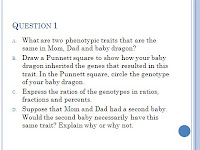Cell Comparison1. Draw a cell. Label the following organelles and identify their function(s): Nucleus, Rough Endoplasmic Reticulum, Smooth Endoplasmic Reticulum, Golgi Apparatus, Vesicle, Vacuole, Mitochondria, Chloroplast, Cilia, Flagella
2. Plant and animal cells are both classified as eukaryotic cells. Name some characteristics of the plant and animal cell that make them different from each other.
3. Plants and animals are made up of eukaryotic cells and bacteria are classified as prokaryotic cells. Name some difference between prokaryotic and eukaryotic cells.
Cell Membrane1. Passive transport is the movement of molecules across a cell membrane without energy input from the cell. Distinguish between diffusion, osmosis and facilitated diffusion.
2. Passive transport does not require energy input from the cell, whereas active transport does require energy input from the cell. How else does passive and active transport differ from each other (hint: purpose for energy input)?
Plant Structure and Function1. Plant cells have distinct difference from animal cells, such as cell walls, large vacuoles, and chloroplasts. How are these differences useful for a plant?
2. Many rain forest plants have tapered leaves. Many plants in cold climate have needle shaped leaves. Why might this be an adaptive advantage for the plants?
3. Draw a leaf structure that you’re familiar with, describe the climate you typically find this plant located, and explain what advantage this leaf has to make it suited for this particular environment.
Cellular Energy1. Diagram the basic process of photosynthesis and write its chemical equation.
2. Diagram the basic process of cellular respiration and write its chemical equation.
3. Describe how and why the processes of photosynthesis and cellular respiration are interrelated.
4. Explain how you do not get energy directly from the food that you eat. How does energy transfer through these processes?
Mitosis & Cancer1. Diagram cell division and describe what occurs during all of the phases of mitosis and cytokinesis.
2. Explain what would happen if each of the four main stages of the cell cycle did not occur.
3. What is cancer and how is it caused? What factors increase risk of cancer?






































